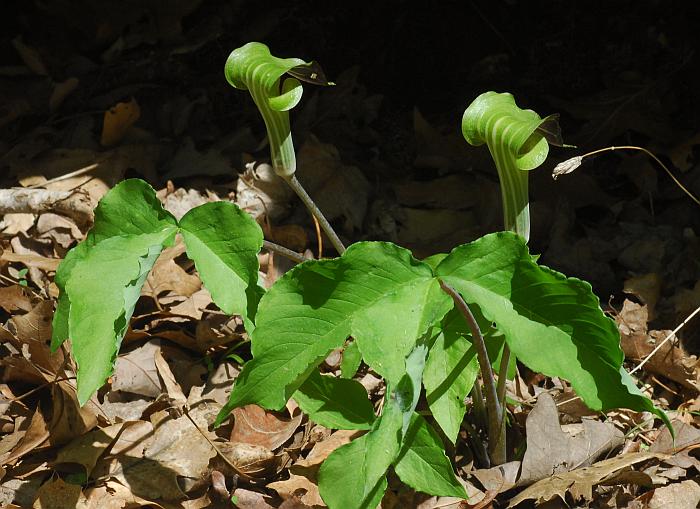Arisaema triphyllum (L.) Schott
Jack-In-The-Pulpit

Native
CC = 6
CW = -3
MOC = 75
© SRTurner
Arisaema triphyllum (L.) SchottJack-In-The-Pulpit | |
 |
Native CC = 6 CW = -3 MOC = 75 |
© SRTurner |
|
Family - Araceae Habit - Perennial monoecious forb from a corm. Stem - Ascending to erect, to 20 cm, glabrous.
Leaves - Alternate, usually 2 per aerial stem, trifoliate. Petioles 30-60 cm, glabrous, the bases sheathing the stem. Leaflets 3, asymmetrically arranged on petiole, glabrous, the largest leaflets to 20 cm long, elliptic to ovate, the lateral leaflets usually asymmetrical. Leaflet lateral venation typically closed in loops, not reaching the leaflet margin.
Inflorescence - Peduncles shorter than petioles. Spathes 10-25 cm long, green, usually with white and dark reddish brown longitudinal markings, the base forming a loose, cylindrical sheath (the "pulpit") around the spadix ("Jack"), the apical half flattened, expanded, and arched over the spadix. Spadices cylindrical, with a blunt sterile tip extending just above the rim of the sheathing portion of the spathe.
Flowers - Minute, numerous, arranged on spadix with staminate flowers above pistillate, or sometimes spadix with entirely staminate or pistillate flowers. Fruits - Dense cylindric cluster of berries, these 1 cm in diameter, red at maturity.
Flowering - April - June. Habitat - Rich bottomlands, mesic forests, and bluff bases. Origin - Native to the U.S. Lookalikes - None. Other info. - This is a species which, when in flower, is instantly recognizable and impossible to mistake for anything else. The "Jack in the Pulpit" structure is not a flower but rather an entire inflorescence. The actual flowers are minute and hidden down in the "pulpit" around "Jack's" shins. This delightful plant is found throughout Missouri, and also across the eastern half of the continental U.S. Its westward extent ends rather abruptly at around the longitude of eastern Kansas and Nebraska. The plant is even easy to identify from the leaves alone, which have their broadly ovate leaflets arranged in a characteristic T-shape. The entire plant can range greatly in size, with large specimens growing waist-high and bearing leaflets a half meter across. The color of the spathe ("pulpit") can vary considerably and has been used to assign infraspecific forms, though these intergrade freely. Photographs taken at Engelmann Woods Natural Area, Franklin County, MO, 4-18-2011 and 4-29-2019, St. Francois State Park, St. Francois County, MO, 5-4-2014, Washington State Park, Washington County, MO, 4-21-2015, near St. Albans, Franklin County, MO, 4-28-2015, Babler State Park, St. Louis County, MO, 4-24-2020, and near Greer Springs, Oregon County, MO, 6-15-2023 (SRTurner). |